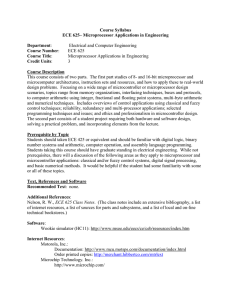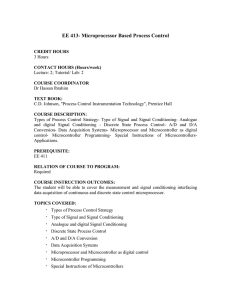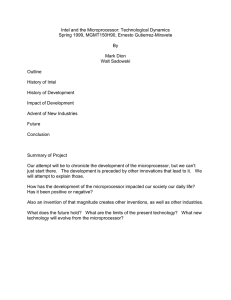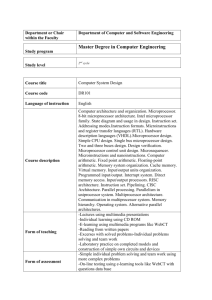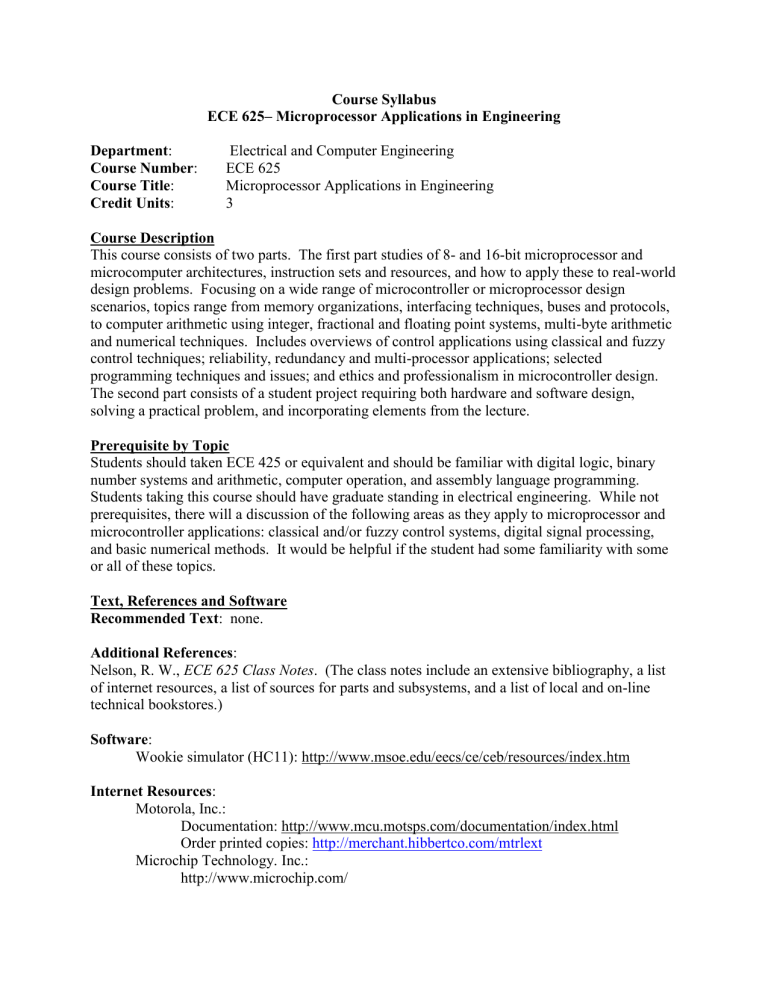
Course Syllabus ECE 625– Microprocessor Applications in Engineering Department: Course Number: Course Title: Credit Units: Electrical and Computer Engineering ECE 625 Microprocessor Applications in Engineering 3 Course Description This course consists of two parts. The first part studies of 8- and 16-bit microprocessor and microcomputer architectures, instruction sets and resources, and how to apply these to real-world design problems. Focusing on a wide range of microcontroller or microprocessor design scenarios, topics range from memory organizations, interfacing techniques, buses and protocols, to computer arithmetic using integer, fractional and floating point systems, multi-byte arithmetic and numerical techniques. Includes overviews of control applications using classical and fuzzy control techniques; reliability, redundancy and multi-processor applications; selected programming techniques and issues; and ethics and professionalism in microcontroller design. The second part consists of a student project requiring both hardware and software design, solving a practical problem, and incorporating elements from the lecture. Prerequisite by Topic Students should taken ECE 425 or equivalent and should be familiar with digital logic, binary number systems and arithmetic, computer operation, and assembly language programming. Students taking this course should have graduate standing in electrical engineering. While not prerequisites, there will a discussion of the following areas as they apply to microprocessor and microcontroller applications: classical and/or fuzzy control systems, digital signal processing, and basic numerical methods. It would be helpful if the student had some familiarity with some or all of these topics. Text, References and Software Recommended Text: none. Additional References: Nelson, R. W., ECE 625 Class Notes. (The class notes include an extensive bibliography, a list of internet resources, a list of sources for parts and subsystems, and a list of local and on-line technical bookstores.) Software: Wookie simulator (HC11): http://www.msoe.edu/eecs/ce/ceb/resources/index.htm Internet Resources: Motorola, Inc.: Documentation: http://www.mcu.motsps.com/documentation/index.html Order printed copies: http://merchant.hibbertco.com/mtrlext Microchip Technology. Inc.: http://www.microchip.com/ Intel Corp.: http://www.intel.com Other sources: Circuit Cellar: http://www.circellar.com http://www.eetoolbox.com/ Course Objectives – After completing this course the students should be able to: Architect a microprocessor or microcontroller system and estimate the required hardware and software resources. Select a microprocessor or microcontroller suitable to the application. Perform the detailed hardware design of a microprocessor or microcontroller system. Program the microprocessor or microcontroller using suitable techniques including use of allocation schemes and device drivers. Find effective solutions to a wide range of real-world microprocessor and microcontroller applications. Topics Covered/Course Outline Review of basic 8- and 16-bit microprocessor and microcontroller architectures, instruction sets and on-chip resources. Memory organizations and interfacing and DMA. Parallel input and output, handshaking, interfacing with common devices. Synchronous and asynchronous serial communication interfaces, topologies and protocols. Waveform and event detection and waveform generation. Analog to digital conversion and issues. Motion detection and control with encoders, sensors, motors and actuators; speed profiles and drive circuits. Low power operation. Computer arithmetic using integer, fractional and floating point systems. Binary and BCD arithmetic and multi-byte arithmetic. CORDIC algorithm and other numerical techniques. Overview of control systems with classical and fuzzy logic control. Embedded control issues: interrupt latency, resource allocation and prioritization, time slicing, device drivers, real-time operating systems. Reliability, redundancy and multi-processor applications. Ethics and professionalism in embedded system design. Relationship to Program Outcomes – This supports the achievement of the following outcomes: a) Ability to apply knowledge of advanced principles to the analysis of electrical and computer engineering problems. b) Ability to apply knowledge of advanced principles to the design of electrical and computer engineering systems. c) Ability to apply the appropriate industry practices, emerging technologies, state-of-the-art design techniques, software tools, and research methods of solving electrical and computer engineering systems. d) Ability to use the appropriate state-of-the-art engineering references and resources, including IEEE research journals and industry publications, needed to find the best solutions to electrical and computer engineering problems. e) Ability to communicate clearly and use the appropriate medium, including written, oral, and electronic communications methods. f) Ability to maintain life-long learning and to continue to be motivated to learn new subjects. g) Ability to learn new subjects that are required to solve problems in industry without being on a classroom environment. h) Ability to be competitive in the engineering job market or to be admitted to an excellent Ph.D. program. Prepared by: R. W. (Bill) Nelson January 13, 2003
